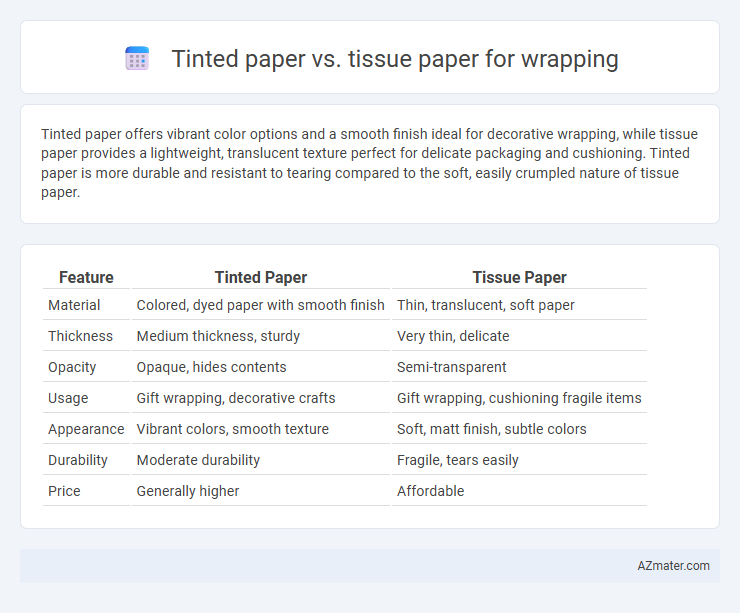Tinted paper offers vibrant color options and a smooth finish ideal for decorative wrapping, while tissue paper provides a lightweight, translucent texture perfect for delicate packaging and cushioning. Tinted paper is more durable and resistant to tearing compared to the soft, easily crumpled nature of tissue paper.
Table of Comparison
| Feature | Tinted Paper | Tissue Paper |
|---|---|---|
| Material | Colored, dyed paper with smooth finish | Thin, translucent, soft paper |
| Thickness | Medium thickness, sturdy | Very thin, delicate |
| Opacity | Opaque, hides contents | Semi-transparent |
| Usage | Gift wrapping, decorative crafts | Gift wrapping, cushioning fragile items |
| Appearance | Vibrant colors, smooth texture | Soft, matt finish, subtle colors |
| Durability | Moderate durability | Fragile, tears easily |
| Price | Generally higher | Affordable |
Introduction to Tinted Paper and Tissue Paper
Tinted paper is a colored wrapping material that adds vibrancy and visual appeal to packaging, often used to enhance product presentation and brand identity. Tissue paper is a lightweight, soft, translucent wrapping option commonly employed for delicate items to provide gentle protection and an elegant touch. Both serve distinct purposes in packaging, with tinted paper emphasizing aesthetic impact and tissue paper prioritizing softness and subtlety.
Key Differences Between Tinted Paper and Tissue Paper
Tinted paper features a smooth finish and vibrant, uniform coloration, making it ideal for elegant gift wrapping and decorative purposes, while tissue paper is thin, translucent, and softer, often used for cushioning and delicate packaging. Tinted paper offers greater durability and opacity, providing better protection and a more polished appearance compared to the lightweight and easily crumpled tissue paper. Cost-wise, tissue paper is typically more affordable and versatile for bulk wrapping needs, whereas tinted paper is favored for premium presentation and structured wrapping designs.
Advantages of Tinted Paper for Wrapping
Tinted paper offers superior opacity and vibrant color options, enhancing the visual appeal and branding of wrapped products. Its smooth texture provides better printability for logos and custom designs, making it ideal for retail packaging and gift presentation. Resistant to tearing and moisture, tinted paper ensures durability while maintaining an elegant appearance.
Benefits of Using Tissue Paper for Wrapping
Tissue paper offers superior softness and flexibility, making it ideal for delicate item protection during wrapping. Its lightweight nature reduces bulk and enhances unwrapping experiences, while its eco-friendly composition supports sustainable packaging. The translucent quality of tissue paper allows for elegant layering and color coordination, adding a refined aesthetic to wrapped gifts.
Appearance and Aesthetic Appeal
Tinted paper offers a vibrant, consistent color and smooth texture ideal for creating bold, eye-catching gift wraps with a polished finish. Tissue paper provides a delicate, translucent quality that adds softness and subtle elegance, perfect for layering and enhancing the presentation with a lightweight, airy feel. Both materials influence the visual appeal significantly, with tinted paper emphasizing vividness and tissue paper emphasizing subtle sophistication.
Strength and Durability Comparison
Tinted paper offers enhanced strength and durability compared to tissue paper due to its denser fiber composition and higher gram weight, making it ideal for wrapping heavier or sharp-edged items. Tissue paper, while softer and more delicate, lacks robustness and is prone to tearing, making it suitable primarily for lightweight or fragile goods. Choosing tinted paper ensures better protection and longevity during handling and transportation, especially for items requiring sturdy packaging.
Cost and Availability Analysis
Tinted paper generally offers a more cost-effective option for wrapping due to its lower production expenses and widespread availability in various shades and weights. Tissue paper, while often preferred for its delicate texture and aesthetic appeal, tends to be pricier because of its specialized materials and limited sourcing. Availability of tinted paper is higher in bulk and standard retail outlets, whereas tissue paper may require specialty suppliers, impacting both procurement time and overall budget.
Best Use Cases for Tinted Paper
Tinted paper is ideal for gift wrapping when a vibrant, colored base enhances the presentation, especially for themed events or branded packaging. It offers a smooth, opaque surface that effectively hides the contents, making it perfect for confidential or surprise items. Tinted paper also pairs well with ribbons and accents, providing a polished look without the translucency or delicacy of tissue paper.
Ideal Situations for Tissue Paper Wrapping
Tissue paper is ideal for wrapping delicate items such as glassware, ceramics, or small gifts due to its soft, lightweight texture that provides cushioning and prevents scratches. It is also perfect for adding a decorative, translucent layer in gift packaging, enhancing presentation while allowing hints of the gift or box color to show through. Tinted paper excels in sturdiness and opacity but lacks the gentle protection and flexibility needed for fragile contents, making tissue paper the preferred choice for wrapping sensitive or intricate objects.
Choosing the Right Wrapping Paper: Final Considerations
Tinted paper offers vibrant colors and opacity, making it ideal for visually striking gift presentations, while tissue paper provides a delicate, lightweight option that adds softness and layers without bulk. Consider the occasion and the fragility of the item when choosing between tinted and tissue paper, as tinted paper provides sturdier protection whereas tissue paper excels in cushioning. For eco-conscious wrapping, opt for recycled or biodegradable versions of either paper type to ensure sustainable gift presentation.

Infographic: Tinted paper vs Tissue paper for Wrapping
 azmater.com
azmater.com